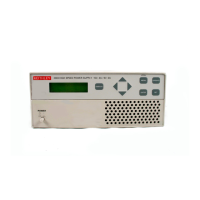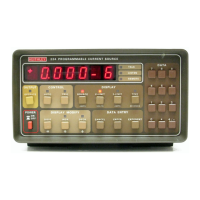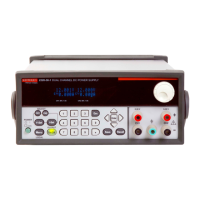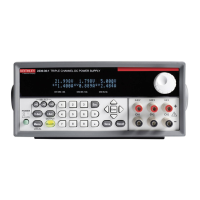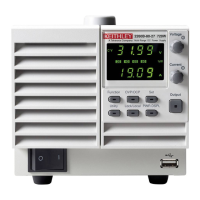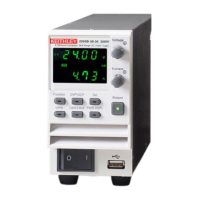6-14 External Triggering (Model 2306-VS Only)
sink or power supply becoming too hot. This is done to handle the situation where the
supply is constantly being driven by trigger in pulses. As soon as the trigger out pulses
for a channel, a trigger in pulse can be generated for that channel. If this happens too
quickly, the unit is constantly handling the trigger external features and has little time, if
any, to handle other tasks like front panel, bus commands, and detecting current limiting.
Therefore, the unit may appear to be locked up or responding very sluggishly. Reducing
the rate of trigger in pulses should alleviate the slow responsiveness. Even though
current limit limiting will be detected by firmware as time permits for processing, the
hardware will respond quickly.
14. If the trigger external feature involves taking a measurement, the unit will store enough
informa
tion about a step's measurement to be able to post process the measurement into
a reading after taking the STEP:POINts measurement. This allows the turn around time
between steps to be optimized by not doing all of the post processing necessary to store
a reading in the buffer for FETCh:ARRay? query. However, after taking the
STEP:POINts measurement, the post processing for all points occurs before the trigger
out pulses for that step. For example, if STEP:POINts equals 20 then steps 1 to 19 will
see a faster time for trigger in to trigger out than the time for step 20's trigger in to trigger
out. This happens since step 20 after completing it's measurement will then post process
all 20 measurements into the buffer for a FETCh:ARRay? query. With this
implementation, the status bits for reading available, reading overflow, and buffer full
will not occur until the last step's measurement completes and post processing starts. If
all steps are not performed, the temporary stored measurements are not available for
viewing. The only way to see the measurements is to complete all steps.
15. If an exception is detected while processing a trigger in pulse, b
ut before it completes the
required configuration functionality, the trigger out pulse will not be generated.
16. Do not perform a PCUR AUTO (Section 3) or LINT AUTO (Section 4) time sequence
while a channel is being externally triggered. Doing so may result in erroneous pulse
times.
Table 6-2
External trigger sequences for various operating modes
BOTH VOLT READ Sequence After Detecting Trigger In Pulse
OFF ON NONE (See programming example number 5.)
1. The channel voltage will step.
2. The step delay setting will elapse.
3. The channel trigger out pulse will handshake.
OFF ON SYNC 1. The channel voltage will step.
2. The step delay setting will elapse.
3. A synchronized pulse current measurement wi
ll be triggered.
a. A valid trigger level setting is needed
b. Measurement will sync to pulse edge – rising/falling.
4. Store measurement in the buffer.
5. The channel trigger out pulse will handshake.
Test Equipment Depot - 800.517.8431 - 99 Washington Street Melrose, MA 02176
TestEquipmentDepot.com
